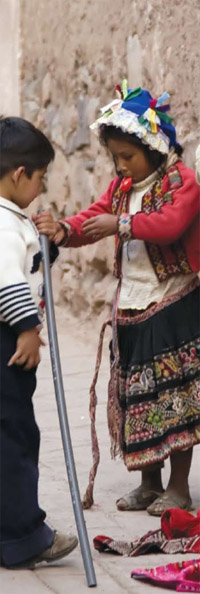As Hernando De Soto (2000) has demonstrated, property rights to land and dwellings in developing nations are notoriously insecure—a fact that has helped impoverish the citizens of those nations. More generally, well-defined and enforced property rights are pivotal in shaping long-run economic growth and, thus, prosperity. Recent research by Erica Field (2007) is helping us understand one mechanism by which secure property rights raise wealth and improve the human condition: When rights to property are secure, people can spend their time creating wealth rather than defending it.

By the early 1990s, there were enough squatters to make them effective in agitating for change. Hence, between 1996 and 2003, the Peruvian government sought to strengthen property rights by issuing property titles to more than 1.2 million urban households, whose 6.3 million members comprised one-quarter of Peru’s population. Thus, in a short period of time, a large portion of the population experienced a remarkable change in property rights—one that enabled them to venture out of their homes, secure in the knowledge that they would have homes to which they could return at the end of the day.
Field finds that once individuals had secure property titles, their behavior changed notably in two key dimensions. First, because the titling program meant that people no longer had to be physically present to defend their property against invasion or confiscation, many more people could seek employment outside the home. The result was a 14 percent increase in labor supply, or about one additional worker per household added to the labor market. This, in turn, increased household incomes.
Second, squatters had found that adults were more effective at protecting property than were children. Prior to the titling program, many children thus had been working (rather than going to school), so that adults could stay at home to defend their land. Once the titling program began, adults took the place of children in the workforce, enabling many more children to spend their days in school. This effect was particularly evident in smaller families, where there had been a greater reliance on child labor.
A key proximate effect of the program has been its positive impact on the wealth of a substantial proportion of Peru’s population: Instead of devoting their efforts to defending their wealth, squatters can now spend their time creating new wealth. This has raised the standard of living, which in turn will lead to improvements in longevity and reductions in disease and infant mortality. And because the program has reduced child labor, it also increases the chances children will become better educated—which, in turn, should increase future incomes.
Although Field’s research does not go beyond examining the labor market implications of secure property rights, there are clear reasons to believe the titling program will have salutary effects in other dimensions. For example, because the program has increased the integration of urban residents with the market economy, it is likely that their attachment to and confidence in the market will increase. This can do nothing but increase Peruvian sentiments in favor of greater reliance on the marketplace as a means of allocating resources.
There are even reasons to believe that the titling program ultimately will result in environmental improvements in Peru. It is well established that as incomes rise, people demand more environmental amenities, such as cleaner air and water. Because the titling program increases both current income and future income, it is likely to raise the demand for environmental protection in Peru. Moreover, because the program has raised reliance on and familiarity with the marketplace, it is plausible that it will also enhance the willingness of people to turn to the market (rather than to a system of command and control) to achieve environmental goals.
The sources of human misery and environmental degradation are varied and complex. But there is little doubt that poor institutions, most notably insecure property rights, play a pivotal role in both. Through the remarkably simple expedient of securing titles to property, Peru is demonstrating that improved institutions are both feasible and beneficial. It is a powerful lesson that could usefully be learned by governments around the world.
References:
De Soto, Hernando. 2000. The Mystery of Capital. New York: Basic Books. Field, Erica. 2007. Entitled to Work: Urban Property Rights and Labor Supply in Peru. Quarterly Journal of Economics 122(4): 1561-1602.



